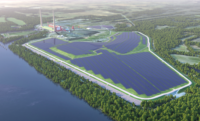The Wyoming Energy Authority has awarded Babcock & Wilcox and its utility partner Black Hills Energy $16 million to fund engineering to begin development of a hydrogen generation facility with carbon dioxide sequestration at the utility's 90-MW coal-fired plant in Gillette. It is one of six state energy demonstration projects with an investment of $157 million that will also leverage more than $120 million in federal funding and private capital, the agency says.
The project will include the firm’s innovative chemical looping system known as BrightLoop that effectively separates CO2 while producing hydrogen, process steam, electricity or syngas for liquid fuel or methanol production, the company says. A variety of solid and gaseous fuels can be used as feedstock, it notes.
The plant, expected to produce 15 tons of blue hydrogen per day “would serve as the foundation for expanded hydrogen production using Powder River Basin coal from across Wyoming,” the authority says.
Brandy Johnson, Babcock & Wilcox chief technology officer said in a statement that the facility would be commercial scale. The Wyoming agency also funded the firm’s technology feasibility study. “It is a novel chemical looping process that is based on the oxidation and reduction of an oxygen carrier particle,” the company said in the statement.
Full construction of an anticipated 200 metric-ton-per-day facility "would provide an economically favorable path to continue use of Wyoming’s coal reserves and allow the state to attain an industry leading levelized cost of hydrogen below $1 per kg," Babcock & Wilcox and Black Hills Energy said in their funding application.
The plant cost and construction start date were not disclosed in the application, and the firms would not comment on status of design firm and contractor selection.
Black Hills Energy says it is a pioneer in use of air cooled condensing technology and mercury emissions controls on coal-fired power plants.
But environmental groups say the state has been slow to tap federal funding sources to develop production of green hydrogen using cleaner energy sources such as solar and onshore wind, according to Inside Climate News.
In Texas, meanwhile, three specialty companies are combining expertise to develop a 500-kg-per-day modular and scalable plant in Houston that will produce, store and dispense green hydrogen from water using a 1.25GW electrolyzer.
HNO International, Element One Energy and Pneumatic and Hydraulic Co. say the system can be scaled to produce more than 5,000 kg of hydrogen per day with additional electrolyzers.
Houston-based HNO designs and develops green hydrogen energy technologies. Element One Energy, Colorado Springs, Colo., designs and manufactures electrolyzers and hydrogen storage systems. Pneumatic and Hydraulic Co. with offices in Louisiana and Texas, supplies hydraulic, filtration and motion control products.
The modular system requires less than 3,000 sq ft and can be powered by the grid or renewable power sources, says HNO.
The firm would not disclose the estimated production plant cost or contractors. Construction should be completed in the fourth quarter.






Post a comment to this article
Report Abusive Comment